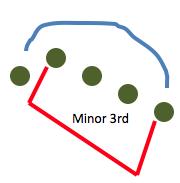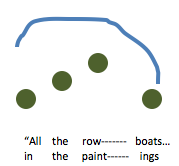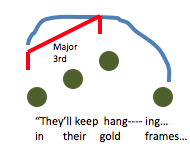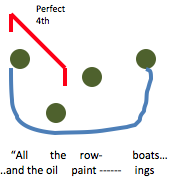 Check out Gary’s book, “Beating Songwriter’s Block – Jump-Start Your Words and Music”, published by Backbeat Books (Hal Leonard).
Check out Gary’s book, “Beating Songwriter’s Block – Jump-Start Your Words and Music”, published by Backbeat Books (Hal Leonard).
Here’s an interesting thought that Yuri, a reader of this blog, suggested to me. Is it possible to have a song hook that’s comprised of motifs? The answer is yes, and it provides a song that’s got a lot of structural integrity with the added benefit of being easy to remember.
First, a couple of definitions. We all know what a hook is: a short, catchy, memorable bit of music that gets repeated over and over throughout a song. It’s usually melodic with a noticeable rhythm attached. And it usually doesn’t change much as a song progresses. The hooky bit you hear in the first chorus is likely to be the last thing you hear, and the last thing you remember.
A motif has some similarities. Like a hook, a motif is a short musical “idea” — a rhythm, a melodic shape, even a bit of lyric — that also gets used throughout a song. But the difference is that a motif does its work in the background.
For example, you might find that you use a particular rhythm: two short notes followed by a long one. Then at a different part of the song, you reverse that idea, using a long note followed by two short ones. That’s not something the average listener would notice. But it strengthens the structure of your music in very important ways.
Here’s a song that demonstrates the difference between hooks and motifs: “All the Rowboats” (Regina Spektor). What we’re going to see is that Spektor sets up a motif — a kind of melodic shape, and then uses that shape in different ways, culminating in the eventual establishing of the chorus hook.
The Intro
The song is in the key of F minor. The intro gives us the main melodic/rhythmic idea that spawns most of the musical elements of this song: a short 5-note figure. There are two things about this figure that are important to the song, and their shown in the diagram below: 1) it spans an interval of a minor third (shown in the red bracket); and 2) it’s shaped like an inverted-U or inverted-V, with the highest note in the middle (shown in the blue curved line).
Verse
So we’ve got a motif that has a melodic component (the minor 3rd interval) and the shape (an inverted U). What we’re going to see happen now is that while the shape stays the same, the interval starts to gradually increase in size. First we get the motif presented in the same way as the intro, even if the rhythms are slightly altered:
As the verse melody progresses, you’ll then hear that minor-3rd interval increase to a major-3rd, still keeping that inverted-U shape:
Chorus
And now we get to the chorus, with two new modifications to that original motif, and an understated chorus hook. First, the shape of the motif flips over so that it starts and end with higher notes, with the lower notes in the middle. Second, the interval of low-to-high note increases to a perfect 4th:
Instrumental Interlude
During this section we hear the motif further developed: The rhythms are elongated, which you can hear at 2’27”. At this point, you’ll hear the higher notes playing the moving-upward part of the melodic motif, while the bass notes play the moving-down component.
As I mentioned, the chorus hook is very understated, but in songs like this, where the idea of motif is a crucial part of the song’s construction, a hook is not as crucial to the viability of the song.
The question is: how much of this kind of motivic manipulation is calculated, and how much is purely instinct? The balance between calculation and instinct depends on the songwriter. Those with a strong classical background (like Spektor) will know all about the power of musical motifs, and know exactly what they’re doing when songs like this come together.
But even without a strong traditional training, songwriters who 1) listen daily to good music, and who 2) ask questions based on a strong sense of musical curiosity, are likely to understand the importance of relating one song section to another through the use of motifs.
In a very real sense, motivic development provides the strongest musical glue for your music, and helps even complicated music make sense to the audience.
________
Written by Gary Ewer. Follow Gary on Twitter.
















Hello Gary . how are you?
I am still studying in parallel with your e-book and blog. I’m studying Motif and Hook these days. I have some questions.
========
1.
[ First question]
It is part [Instrumental Interlude] of the description above.
You said “During this section we hear the motif further developed ”
I want to know more about what you mentioned “the motif further developed”.
I bought the music sheet of “Regina Spektor – All the Rowboats ” and analyzed it.
As you said, if you listen to the Interlude (2:27) of this song, there will be The interval gradually increases from the minor 3rd to perfect 4th , as it was from Intro to Chorus.
In addition, you can see that the interval has been increased up to augmented 5th .
Is this the “motif further developed” you mentioned? Or is there another element of “the motif further developed” in this song? I would like to hear your advice.
=========
2.
[Second question]
The second question is about a posting titled [The Musical Cohesion That Comes From Motifs].
You said ” 1. The rhythms of the backing instruments are borrowed from, or developed from, rhythms found in the melody or other melodic instruments.
2.Melodic shapes played by the backing instruments can be found in other instrumental or vocal parts within the song. ”
I found an example of the above in the song, “Demi Lovato – Cool for the summer “.
Please listen to the Pre-chorus part (1:37) of this song. The rhythm and melody lines of the main guitar appear to match the piano that appears as a backing instrument. And even the vocal melody line is the same.
Is this an appropriate example of the content above? I’d like to know if my understanding is correct.
and If you do not mind, can you give me another example?
========
Finally, I would like to study more about the questions I asked above, which book would be helpful to consult among your 10- e Books ?
I would appreciate your recommendation.
So have a happy day today 🙂
Pingback: Interesting Links For Musicians and Songwritiers – August 14, 2015 | Creative Music | Inspiring Musical Creativity